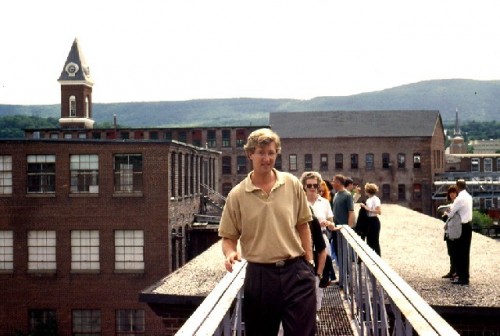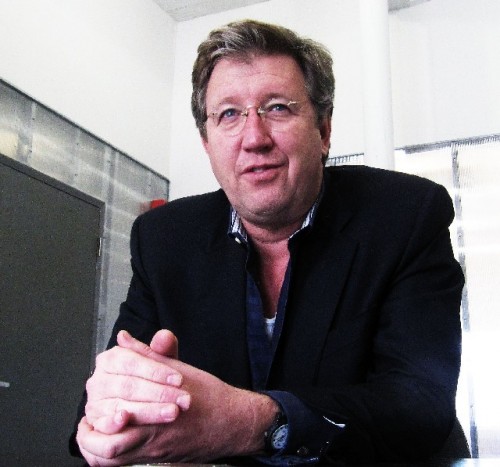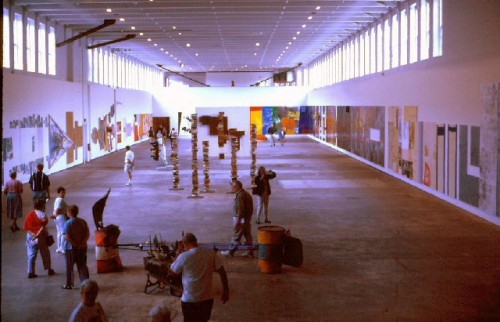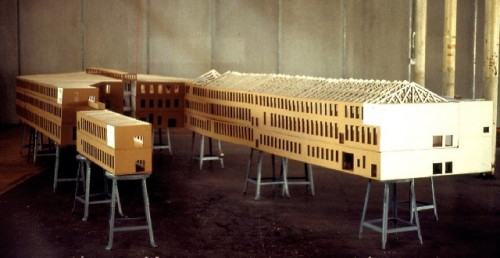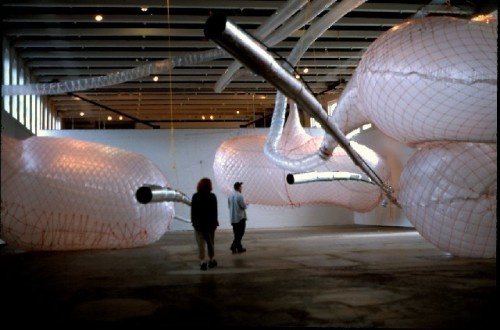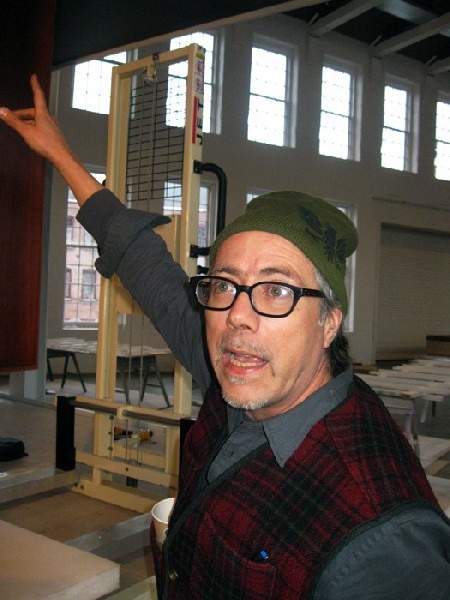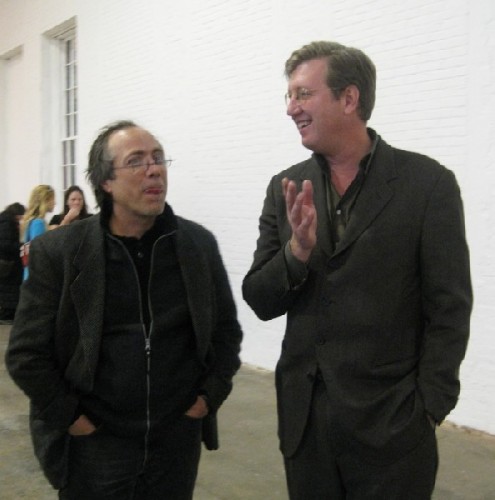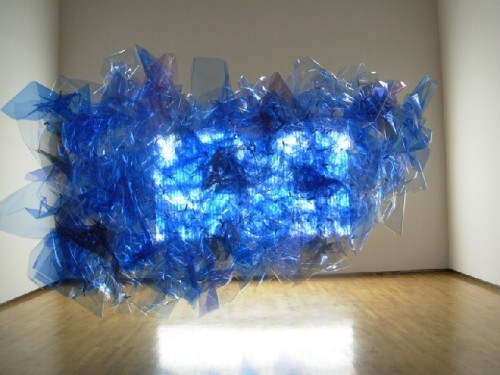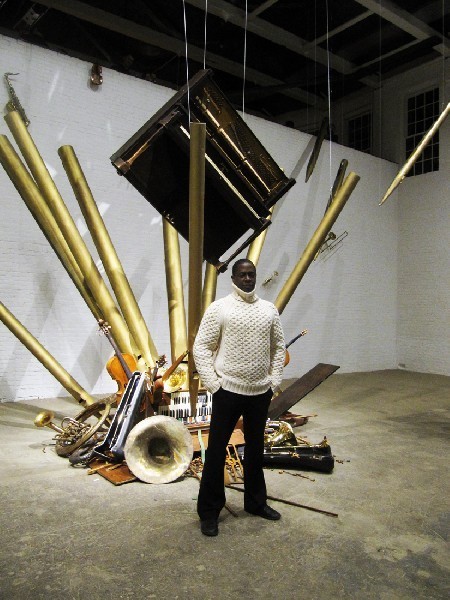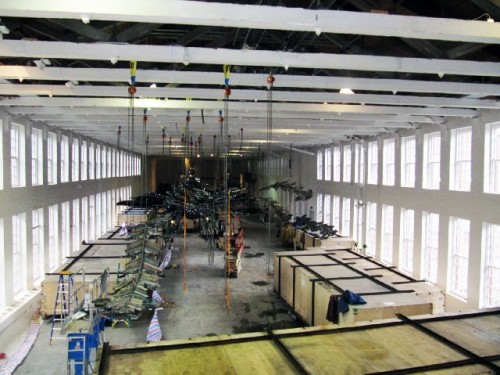Mass MoCA Director Joe Thompson Two
Programming the Vast Building Five
By: Charles Giuliano - Jan 17, 2013
Charles Giuliano What are some of the logistical issues involved with presenting major artists from China?
Joe Thompson The exhibition of Cai Guo-Qiang included almost all new work which we fabricated here; the cars, the film. The only work he brought was one of his gunpowder drawings. Everything else was made here, on site, in our shop. (By fabricator and chief installer Richard Criddle.) So that entailed normal logistical issues for us. To get the cars and make the work. The Xu Bing Phoenix already existed so the issues included having it handled and shipped. Crazily scaled objects coming from half way across the globe.
CG Have you had a chance to see our posting of Xu Bing’s earlier exhibition at Mass College of Art? I was able to scan images I took of that installation and create a slide show. In view of the current show at Mass MoCA it provides an archival reference.
JT I’ll check it out.
CG I enjoyed meeting Xu Bing during the press conference. But, quite frankly, I didn’t find it all that useful. His discussion and responses to questions were poetic but evasive. There was also the difficulty of having his words translated through an interpreter. From his expressions and body language it seemed that he caught most of what was asked in English. He had lived in the States for more than a dozen years.
JT Your Ai Weiwei question was very complicated. You know they lived together for twelve years. They shared an apartment in Brooklyn and were very good friends. I’ve never talked to him about Ai Weiwei. Both of them left after Tiananmen Square (1989). Xu Bing went to Wisconsin first then came back to New York. They rented an apartment and a lot of their early works were done together. My hunch is that the way he answered your question (actually didn’t) was that it was a complicated relationship. We didn’t have time but I wanted to go back to him and say “Now what’s the real answer to that question?”
(To summarize the question there was a comparison between Ai Weiwei’s sculptural metaphor Forge that entailed straightening then recreating the mangled iron rods of an earthquake collapsed school's “tofu construction” that resulted in 5,200 deaths of school children. The work was shown in two versions, at Mary Boone Gallery in New York, and Straight in the Hirshorn Museum retrospective. Similarly, Xu Bing used recycled construction materials from Beijing to create Phoenix. Was there a relationship in the approaches of the artists as well as their political implications? In his response to the question, and during the press conference in general, Xu Bing did not refer to Ai Weiwei or any other artists.)
CG It seemed that he was adept at filibustering to avoid direct questions of a political nature.
JT That’s true but I learned some things which I didn’t know. He mentioned that he is going to make a very long animation which I have been trying to have him include in the exhibition for the past year. I bring it up and he answers by saying “Oh, that could be interesting.” I take that as a Chinese “no.” (both laugh) At the press conference he confirmed that we were going to show that work. That was news to me. It was good news. I was happy to finally have him come out and say it.
CG You get the feeling that these artists are adept at exploiting the cultural differences.
JT Exactly.
CG What’s different about Ai Weiwei is that his comments to the media and during interviews are very direct.
JT Absolutely. The questions that are always put to him include “Is it art or is it politics?” “Are you an artist or an ambassador?” Or is he both?
CG He doesn’t dodge questions (like Xu Bing). He tells it like it is. In that sense he’s amazingly courageous. The Phoenix piece is subversively political.
JT I think it is but he talks around it. There’s a subtlety to what he says if you listen closely. In pre-free market China workers were held in a different regard.
CG Did you read my Xu Bing piece? Do you have any issues that need to be clarified?
JT What I like about your interviews is that you clean them up just enough. You still feel the quality of back and forth. It feels live. But you take out enough that you don’t stumble over the nature of spoken language. You can read it. It reads quickly and you feel that you’re really there.
CG It’s a lot of work.
JT You’re not kidding. I did that one time with a transcript. You don’t want to change the meaning but you want it to read well. It’s hard to do.
CG This is a commitment to oral history. Future generations will want to know, chapter and verse, how these events and works happen.
JT It’s a record and sticks these days. Once it’s on line it’s up forever.
(Actually that’s not entirely true. It’s up for as long as a site is maintained. When a site closes all of the material disappears. While books and periodicals may be archived by the Library of Congress there is no such commitment to on line data. Until this is addressed the entire current generation of internet cultural reporting faces eventual extinction. Until then, through Google and other search engines, there is an abundance of material. Few comprehend that this apparent glut of content is only temporary.)
CG I don’t know how many exhibitions there have been in Building Five, but, overall, I think the Chinese shows have been particularly outstanding. They seem to have the scale and content that commands that vast and demanding space. The Jenny Holzer installation, among others, was outstanding.
JT I just had this discussion with someone else who said the same thing. Say what you will about Chinese artists but they can carry that building. It’s not an easy space. Jenny’s show was great. Robert Wilson’s reinterpretation of the 14 Stations was very strong.
The Chinese artists share a quality which entails an operatic, narrative flow. They give you a powerful image. In this case Xu Bing gives us two powerful images. The first one is the light box which we encounter entering the space. It’s a metaphor and then there’s the big reveal.
CG On a global level there are only a few places with spaces comparable to Mass MoCA and its Building Five. One thinks of Dia Beacon. We were fortunate to visit the many buildings of the Chinati Foundation in Marfa, Texas. As well as Frank Gehry’s Guggenheim Bilbao.
JT Also Turbine Hall at Tate Modern in London.
CG There are just a few epic scaled exhibition spaces on a global level. Mass MoCA is one of them. It’s an enormous challenge.
JT They don’t always work. When given the opportunity artists either really take on the space and activate it or they work against it. Or go for a Zen moment in the middle. There’s that feeling you have of walking down a long space.
CG Denise Markonish described that to me as “the approach.”
JT Simon Starling certainly did that. Inigo gave us that beautiful structure way down at the end. You had to walk, walk, walk, way down to it. It was about deferral and consciousness in some ways.
CG There seem to be two approaches to Building Five; Half empty, or half full.
JT (Laughs) Exactly.
CG We have seen both. The Timothy Hawkesworth was full while the Inigo Manglano-Ovalle was empty. Sanford Biggers’ last year was in between. Are there other upcoming Chinese projects?
JT We’re always looking. One thing leads to another. We’re all human beings. You meet the next person through your current project. You meet artists. They introduce you to their friends. People come to see shows. Once you become immersed in a culture or circle of artists it often leads to the next thing. Having said that we don’t have a next thing yet. We have a couple of ideas but not Chinese.
CG What’s your batting average for the major shows? There was a famous one that didn’t work (Christoph Buchel).
JT That was a potentially great one.
An investment banker told me that you are doing well if one in seven of your investments are successful. If you can hold to a one to seven ratio you’ll do quite well in investment banking. I think we’re doing better than that.
CG How long now has Mass MoCA been operational?
JT It’s our 14th year coming up. Since 1999.
CG What impact has Mass MoCA had on contemporary art?
JT Certainly for individual artists and in the realm of ideas we have had shows that have produced a beautiful light on a handful of artists who were already viewed as important artists, even if they were not already recognized to the extent that they deserve. We did a beautiful Matthew Ritchie show. The Spencer Finch exhibition brought together a body of work that helped us understand its total scope. He’s an artist who refuses to make the same work twice. There are always new materials. It’s hard to find a signature.
CG That also describes Charles Ray.
JT His work is so demanding in so many ways. I’m a deep admirer.
The Cai Guo-Qiang show was pivotal in his career. It went from here to the Guggenheim. His career has done nothing but go up since. There are shows like that occasionally.
The Oh Canada show has generated a lot of dialogue about Canadian art. The Wall Street Journal had an article about it just last week. Within Canada it has stimulated a tremendous amount of debate. We’re in the same business that you are. We put something out there and hope that three people pay attention.
CG We have touched on this through e mail. For the Xu Bing coverage I went back and found earlier articles to repost and link to. It can be embarrassing to read something you wrote as recently as just a couple of years ago. As writers we grow, evolve, and make mistakes in public. It can be sobering. We like to think that our work is always getting better. So it is uncomfortable to look back on earlier efforts. The same may be said for museum directors. I first met you, some 20 plus years ago, as a fairly recent Williams graduate with a vision for Mass MoCA. How are you different today than you were through the growing pains of the museum?
JT I would hope so. I think you answered your question. At the moment that we’re involved in an exhibition I always feel it’s the most important and interesting thing that we’ve ever done. Of course, by definition, that’s never going to be true, particularly as time goes on. Some of it sticks. You hope enough takes hold that people keep coming. I like it when I read Mass MoCA mentioned in passing. A review or feature when there is mention of an artist having participated in an earlier show at Mass MoCA. That in passing quality has an implicit assumption that the institution exists and will exist. It’s a part of the cultural world in that assumption. That makes me feel very satisfied because it wasn’t always true.
CG You have also had the experience of dealing with very young curators. At this time Laura Heon and Nato Thompson have moved on. Denise Markonish came here at a relatively early phase of her career. By comparison, Susan Cross is a senior citizen in the curatorial field. In creating the museum you worked from the seat of your pants. Over time you have grown into the position. There was a milestone recently when Katherine Myers left. (The director of marketing and public relations now employed by the Williams College Museum of Art.)
JT Katherine was with us for 14 years.
CG When I was teaching college it seemed that each year I was older but students stayed the same. With time the generational and communications gap grew ever wider.
JT (Laughs) I know what you mean.
CG How is that a phenomenon for you? You’re dealing with young curators.
JT They’re earning their chops.
CG At this point you’re more of a mentor overseeing their work. Where 14 years ago curators were more like your peers. One imagines that evokes a very different kind of dialogue. That changed dynamic is interesting.
JT It is interesting. Kathy Halbreich gave me the best advice on that one. (Formerly director of the Walker Arts Center she joined the Museum of Museum of Modern Art in the newly created position of Associate Director in February 2008.) After she resigned from the Walker, following a very long and successful tenure, I asked “How did you know when to go?” In a one or two day period, she told me, she found herself telling younger staff “We’ve tried that before already.” The third time she said that in a couple of days, to a young and excited staff with new ideas, she realized she had been there long enough. Kathy’s advice and wisdom is profound.
CG So how do you remain fresh?
JT There’s still a lot to be done at Mass MoCA. It’s beginning to feel that there are real legs under it and that it will be there for a long time. There are still things coming down the pike that are totally engaging.

